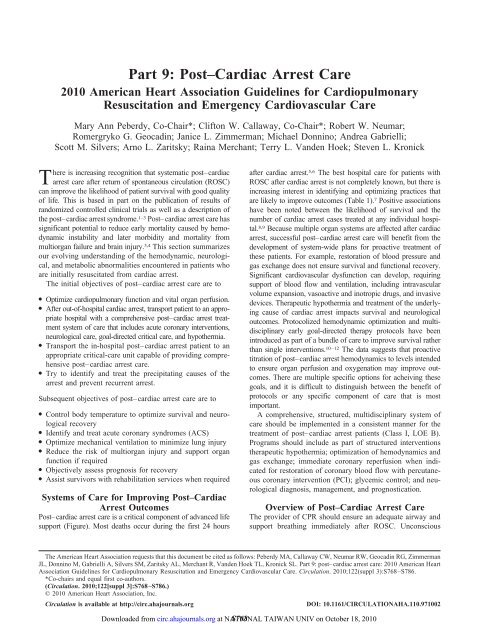2010 American Heart Association
2010 American Heart Association
2010 American Heart Association
Create successful ePaper yourself
Turn your PDF publications into a flip-book with our unique Google optimized e-Paper software.
Part 9: Post–Cardiac Arrest Care<br />
<strong>2010</strong> <strong>American</strong> <strong>Heart</strong> <strong>Association</strong> Guidelines for Cardiopulmonary<br />
Resuscitation and Emergency Cardiovascular Care<br />
Mary Ann Peberdy, Co-Chair*; Clifton W. Callaway, Co-Chair*; Robert W. Neumar;<br />
Romergryko G. Geocadin; Janice L. Zimmerman; Michael Donnino; Andrea Gabrielli;<br />
Scott M. Silvers; Arno L. Zaritsky; Raina Merchant; Terry L. Vanden Hoek; Steven L. Kronick<br />
There is increasing recognition that systematic post–cardiac<br />
arrest care after return of spontaneous circulation (ROSC)<br />
can improve the likelihood of patient survival with good quality<br />
of life. This is based in part on the publication of results of<br />
randomized controlled clinical trials as well as a description of<br />
the post–cardiac arrest syndrome. 1–3 Post–cardiac arrest care has<br />
significant potential to reduce early mortality caused by hemodynamic<br />
instability and later morbidity and mortality from<br />
multiorgan failure and brain injury. 3,4 This section summarizes<br />
our evolving understanding of the hemodynamic, neurological,<br />
and metabolic abnormalities encountered in patients who<br />
are initially resuscitated from cardiac arrest.<br />
The initial objectives of post–cardiac arrest care are to<br />
● Optimize cardiopulmonary function and vital organ perfusion.<br />
● After out-of-hospital cardiac arrest, transport patient to an appropriate<br />
hospital with a comprehensive post–cardiac arrest treatment<br />
system of care that includes acute coronary interventions,<br />
neurological care, goal-directed critical care, and hypothermia.<br />
● Transport the in-hospital post–cardiac arrest patient to an<br />
appropriate critical-care unit capable of providing comprehensive<br />
post–cardiac arrest care.<br />
● Try to identify and treat the precipitating causes of the<br />
arrest and prevent recurrent arrest.<br />
Subsequent objectives of post–cardiac arrest care are to<br />
● Control body temperature to optimize survival and neurological<br />
recovery<br />
● Identify and treat acute coronary syndromes (ACS)<br />
● Optimize mechanical ventilation to minimize lung injury<br />
● Reduce the risk of multiorgan injury and support organ<br />
function if required<br />
● Objectively assess prognosis for recovery<br />
● Assist survivors with rehabilitation services when required<br />
Systems of Care for Improving Post–Cardiac<br />
Arrest Outcomes<br />
Post–cardiac arrest care is a critical component of advanced life<br />
support (Figure). Most deaths occur during the first 24 hours<br />
after cardiac arrest. 5,6 The best hospital care for patients with<br />
ROSC after cardiac arrest is not completely known, but there is<br />
increasing interest in identifying and optimizing practices that<br />
are likely to improve outcomes (Table 1). 7 Positive associations<br />
have been noted between the likelihood of survival and the<br />
number of cardiac arrest cases treated at any individual hospital.<br />
8,9 Because multiple organ systems are affected after cardiac<br />
arrest, successful post–cardiac arrest care will benefit from the<br />
development of system-wide plans for proactive treatment of<br />
these patients. For example, restoration of blood pressure and<br />
gas exchange does not ensure survival and functional recovery.<br />
Significant cardiovascular dysfunction can develop, requiring<br />
support of blood flow and ventilation, including intravascular<br />
volume expansion, vasoactive and inotropic drugs, and invasive<br />
devices. Therapeutic hypothermia and treatment of the underlying<br />
cause of cardiac arrest impacts survival and neurological<br />
outcomes. Protocolized hemodynamic optimization and multidisciplinary<br />
early goal-directed therapy protocols have been<br />
introduced as part of a bundle of care to improve survival rather<br />
than single interventions. 10–12 The data suggests that proactive<br />
titration of post–cardiac arrest hemodynamics to levels intended<br />
to ensure organ perfusion and oxygenation may improve outcomes.<br />
There are multiple specific options for acheiving these<br />
goals, and it is difficult to distinguish between the benefit of<br />
protocols or any specific component of care that is most<br />
important.<br />
A comprehensive, structured, multidisciplinary system of<br />
care should be implemented in a consistent manner for the<br />
treatment of post–cardiac arrest patients (Class I, LOE B).<br />
Programs should include as part of structured interventions<br />
therapeutic hypothermia; optimization of hemodynamics and<br />
gas exchange; immediate coronary reperfusion when indicated<br />
for restoration of coronary blood flow with percutaneous<br />
coronary intervention (PCI); glycemic control; and neurological<br />
diagnosis, management, and prognostication.<br />
Overview of Post–Cardiac Arrest Care<br />
The provider of CPR should ensure an adequate airway and<br />
support breathing immediately after ROSC. Unconscious<br />
The <strong>American</strong> <strong>Heart</strong> <strong>Association</strong> requests that this document be cited as follows: Peberdy MA, Callaway CW, Neumar RW, Geocadin RG, Zimmerman<br />
JL, Donnino M, Gabrielli A, Silvers SM, Zaritsky AL, Merchant R, Vanden Hoek TL, Kronick SL. Part 9: post–cardiac arrest care: <strong>2010</strong> <strong>American</strong> <strong>Heart</strong><br />
<strong>Association</strong> Guidelines for Cardiopulmonary Resuscitation and Emergency Cardiovascular Care. Circulation. <strong>2010</strong>;122(suppl 3):S768–S786.<br />
*Co-chairs and equal first co-authors.<br />
(Circulation. <strong>2010</strong>;122[suppl 3]:S768–S786.)<br />
© <strong>2010</strong> <strong>American</strong> <strong>Heart</strong> <strong>Association</strong>, Inc.<br />
Circulation is available at http://circ.ahajournals.org DOI: 10.1161/CIRCULATIONAHA.110.971002<br />
Downloaded from<br />
circ.ahajournals.org at NATIONAL S768 TAIWAN UNIV on October 18, <strong>2010</strong>















